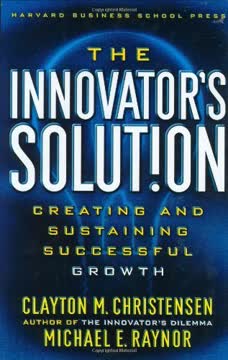Key Takeaways
1. Disruptive innovations initially underperform but eventually overtake established markets
Disruptive technologies bring to a market a very different value proposition than had been available previously.
Disruptive technologies start small. They often emerge in niche markets, offering products that are simpler, more convenient, or less expensive than mainstream offerings. Initially, these innovations underperform established products in key performance metrics valued by mainstream customers.
Performance improvement trajectories. However, the performance of disruptive technologies improves at a faster rate than market demands. This allows them to eventually meet and exceed the needs of mainstream customers, often at a lower cost or with added convenience.
- Examples of disruptive innovations:
- Personal computers vs. mainframes
- Minimill steel production vs. integrated mills
- Hydraulic excavators vs. cable-actuated shovels
2. Resource allocation processes favor sustaining over disruptive technologies
Because failure is intrinsic to the process of finding new markets for disruptive technologies, the inability or unwillingness of individual managers to put their careers at risk acts as a powerful deterrent to the movement of established firms into the value networks created by those technologies.
Established processes reinforce the status quo. In successful companies, resource allocation processes are designed to support sustaining innovations that improve products for existing customers. These processes make it difficult to allocate resources to disruptive projects with uncertain outcomes.
Career incentives discourage risk-taking. Managers are often reluctant to champion disruptive projects because failure could harm their career prospects. This risk aversion further entrenches the focus on sustaining innovations.
- Challenges in allocating resources to disruptive projects:
- Uncertain market size and potential
- Lower initial profit margins
- Resistance from existing customers
- Misalignment with current organizational processes and values
3. Small markets don't solve the growth needs of large companies
An opportunity that excites a small organization isn't big enough to be interesting to a very large one.
The growth conundrum. Large, successful companies need substantial new opportunities to maintain their growth rates. Small, emerging markets created by disruptive technologies often don't offer enough near-term revenue potential to be attractive.
Asymmetric motivation. This size mismatch creates an opportunity for small, entrepreneurial firms to establish footholds in new markets without immediate competition from industry incumbents. By the time the market grows large enough to interest established players, entrants often have insurmountable advantages.
- Factors influencing market attractiveness:
- Current company size and growth expectations
- Projected market size and growth rate
- Alignment with existing customer base and distribution channels
- Required investment and expected returns
4. Markets that don't exist can't be analyzed using traditional methods
Managers who believe they know a market's future will plan and invest very differently from those who recognize the uncertainties of a developing market.
Traditional market research falls short. When dealing with disruptive innovations, conventional market analysis techniques are often ineffective because the market doesn't yet exist. Customers can't articulate needs for products they haven't experienced.
Discovery-driven planning. Instead of relying on detailed forecasts, companies should adopt a learning-oriented approach. This involves setting clear assumptions, testing them in the market, and being prepared to pivot based on new information.
- Key elements of discovery-driven planning:
- Clearly stated assumptions about the market and technology
- Small-scale experiments to test hypotheses
- Rapid iteration based on market feedback
- Flexibility to change course as new information emerges
5. A company's capabilities reside in its processes and values
Processes and values are the factors that define what an organization can and cannot do.
Beyond individual skills. While talented individuals are important, a company's true capabilities are embedded in its processes (how things are done) and values (what is prioritized). These elements are often invisible but critically shape an organization's ability to innovate.
The capability-rigidity paradox. The very processes and values that make a company successful with its current business model can become handicaps when facing disruptive change. This explains why highly capable organizations often struggle with disruptive innovations.
- Components of organizational capabilities:
- Resources: Tangible assets like people, technology, and capital
- Processes: Patterns of interaction, coordination, and decision-making
- Values: Criteria used for prioritization and resource allocation
6. Spin-out organizations are crucial for commercializing disruptive innovations
A separate organization is required when the mainstream organization's values would render it incapable of focusing resources on the innovation project.
Overcoming organizational constraints. Established companies often struggle to pursue disruptive innovations within their existing structures. Creating an independent organization with its own processes and values can overcome these limitations.
Autonomy with support. Successful spin-outs maintain independence in decision-making while leveraging the parent company's resources. This allows them to develop new capabilities tailored to the disruptive opportunity without being constrained by the parent's existing business model.
- Key considerations for spin-out organizations:
- Separate P&L responsibility
- Freedom to develop new processes and values
- Ability to target appropriate initial markets
- Access to parent company resources when beneficial
- Clear leadership support from top executives
7. The basis of competition changes as markets evolve
Performance oversupply triggers a shift in the basis of competition, and the criteria used by customers to choose one product over another changes to attributes for which market demands are not yet satisfied.
The performance oversupply phenomenon. As technologies improve faster than market demands, products eventually exceed customer needs along the primary performance dimension. This shifts competition to other attributes, such as convenience, reliability, or price.
Product life cycle progression. This pattern of shifting competitive bases often follows a predictable sequence: functionality, reliability, convenience, and price. Understanding this progression helps companies anticipate and prepare for market changes.
- Stages of competitive focus:
- Functionality: Meeting basic performance needs
- Reliability: Consistent, dependable performance
- Convenience: Ease of use and integration
- Price: Cost becomes the primary differentiator
8. Listening to current customers can be detrimental when facing disruptive change
One of the bittersweet rewards of success is, in fact, that as companies become large, they literally lose the capability to enter small emerging markets.
The innovator's dilemma. Established companies' focus on serving their best customers can blind them to disruptive threats. These customers often don't value the attributes of disruptive technologies, leading companies to overlook or dismiss their potential.
Breaking free from customer dependence. To succeed with disruptive innovations, companies must be willing to pursue opportunities that their current customers may not value. This often requires targeting new customer segments or creating entirely new markets.
- Pitfalls of over-reliance on current customers:
- Missed opportunities in emerging markets
- Incremental rather than disruptive innovation
- Vulnerability to new entrants with different value propositions
- Difficulty recognizing when the basis of competition is shifting
9. Disruptive technologies often enable new markets to emerge
Often, the very attributes that render disruptive technologies useless in mainstream markets that constitute their value in new markets.
Creating new value networks. Disruptive technologies frequently find their first applications in emerging or low-end market segments. These new markets value the unique attributes of the disruptive technology, even if they are seen as weaknesses in mainstream markets.
Market creation through iteration. The process of finding and developing these new markets is often unpredictable and requires experimentation. Successful companies remain flexible and adapt their approach based on market feedback.
- Strategies for identifying new markets:
- Focus on non-consumers or over-served customers
- Look for jobs-to-be-done that are poorly addressed by current solutions
- Experiment with different applications and use cases
- Be open to unexpected market opportunities
10. Success with disruptive innovations requires a discovery-driven approach
Plans to learn rather than plans for implementation.
Embracing uncertainty. When pursuing disruptive innovations, companies must accept that traditional planning methods are inadequate. Instead, they should adopt a learning-oriented approach that emphasizes flexibility and adaptation.
Creating a learning organization. Success with disruptive innovations requires building organizational capabilities for rapid experimentation, learning, and adjustment. This involves creating processes for testing assumptions, gathering market feedback, and pivoting based on new information.
- Key elements of a discovery-driven approach:
- Setting clear assumptions and hypotheses
- Designing low-cost experiments to test critical unknowns
- Establishing metrics for learning and progress
- Creating mechanisms for rapid decision-making and course correction
- Cultivating a culture that embraces failure as a learning opportunity
Last updated:
FAQ
What's The Innovator's Dilemma about?
- Focus on company failures: The book examines why successful companies often fail when faced with disruptive technologies, despite having strong management practices.
- Disruptive vs. sustaining technologies: It differentiates between sustaining technologies that enhance existing products and disruptive technologies that initially underperform but eventually dominate the market.
- Case studies: Christensen uses examples from industries like disk drives and excavators to show how established firms miss opportunities by focusing on current customer needs.
Why should I read The Innovator's Dilemma?
- Understanding innovation dynamics: The book offers insights into how companies can effectively navigate technological changes.
- Practical frameworks: It provides frameworks and principles for managers to recognize and respond to disruptive technologies.
- Real-world examples: The use of case studies makes the concepts relatable and applicable to various business contexts.
What are the key takeaways of The Innovator's Dilemma?
- Disruptive innovation principle: Successful companies often fail by focusing on sustaining innovations, neglecting disruptive technologies.
- Resource dependence theory: Customers control resource allocation, which can hinder companies from pursuing disruptive innovations.
- Need for independent organizations: Companies should create separate units to explore disruptive technologies without existing customer constraints.
What is the definition of disruptive technology in The Innovator's Dilemma?
- Underperformance initially: Disruptive technologies start by underperforming in mainstream markets but offer features valued by fringe customers.
- Market transformation: Over time, these technologies improve and meet mainstream performance needs, leading to market disruption.
- Examples provided: Christensen cites personal computers and hydraulic excavators as examples of disruptive technologies reshaping industries.
How does The Innovator's Dilemma explain the failure of great companies?
- Good management paradox: Effective management can lead to failure when companies ignore disruptive technologies.
- Customer focus: Companies often listen too closely to current customers, missing emerging market needs and opportunities.
- Historical case studies: Examples from companies like Sears and IBM show how well-managed firms can stumble with disruptive changes.
How do established companies typically respond to disruptive technologies?
- Focus on sustaining innovations: Established firms often concentrate on improving existing products, neglecting disruptive innovations.
- Resource allocation challenges: They struggle to reallocate resources to disruptive technologies due to existing processes and values.
- Failure to adapt: This focus can lead to a failure to recognize and respond to emerging threats, resulting in loss of market share.
What is the role of market research in identifying disruptive technologies?
- Limited effectiveness: Traditional market research often fails to identify potential markets for disruptive technologies.
- Need for exploration: Companies should use exploratory approaches, like trial and error, to discover new markets for disruptive technologies.
- Customer insights: Observing customer product use can provide valuable insights, as customers may not yet understand their own needs.
How can companies successfully manage disruptive innovations?
- Separate organizations: Companies should create independent units to focus on disruptive technologies without mainstream business constraints.
- Flexible planning: Managers should adopt a learning-oriented approach, planning for iterations and adjustments.
- Focus on simplicity: Initial products should be simple and convenient, targeting markets that value these attributes.
What are the principles of disruptive innovation outlined in The Innovator's Dilemma?
- Resource dependence: Companies rely on customers and investors for resources, limiting their ability to pursue disruptive technologies.
- Small markets: Established firms often overlook small, emerging markets that could become significant as disruptive technologies evolve.
- Organizational capabilities: An organization's capabilities can define its disabilities when confronting disruptive innovations.
What are the best quotes from The Innovator's Dilemma and what do they mean?
- "Good management was the most powerful reason they failed to stay atop their industries.": Highlights the paradox of effective management leading to failure with disruptive change.
- "Markets that don’t exist can’t be analyzed.": Emphasizes the difficulty of predicting disruptive technologies' success, as they create new markets.
- "Technology supply may not equal market demand.": Underscores the disconnect when technological advancements outpace market needs.
How does The Innovator's Dilemma suggest companies should structure their organizations?
- Tailored structures: Organizations should match their structure to the specific needs of the technology and market they address.
- Autonomous units: Creating autonomous units allows for new processes and values that align with disruptive technologies.
- CEO oversight: Direct CEO oversight ensures new organizations receive necessary resources and support.
How does The Innovator's Dilemma relate to modern business challenges?
- Relevance to current industries: The principles apply to modern industries facing rapid technological changes, like technology and healthcare.
- Guidance for managers: It provides a framework for managers to recognize and respond to disruptive threats in their industries.
- Strategic foresight: Encourages companies to develop strategic foresight to anticipate and adapt to emerging technologies and market shifts.
Review Summary
Readers praise Christensen's groundbreaking analysis of why successful companies fail when faced with disruptive technologies. Many find the concepts eye-opening and still relevant decades after publication. While some criticize the dated examples and repetitive writing style, most agree it's a must-read for understanding innovation in business. The book is particularly valued for its well-researched case studies and actionable frameworks for managing disruptive change.
Similar Books

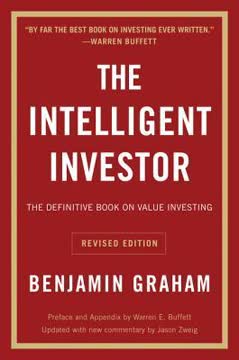
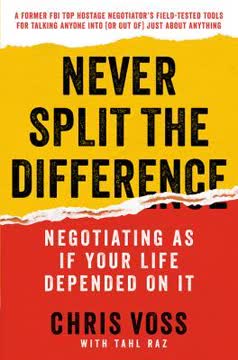


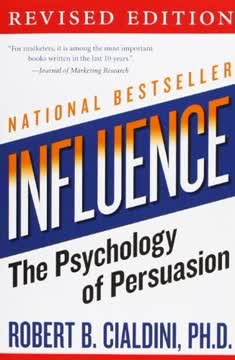


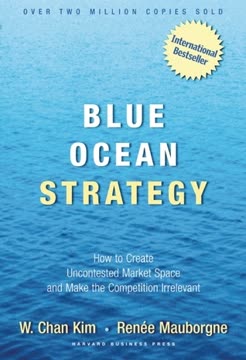

Download PDF
Download EPUB
.epub digital book format is ideal for reading ebooks on phones, tablets, and e-readers.



